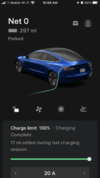Went searching and as a by-product, found this from Tesla....
The whole article is interesting.

www.tesla.com
Calendar Life
Li-ion cells lose capacity with time, even if they are just sitting on a shelf. They lose the most early in their life (year one) and then continue to lose capacity gradually thereafter. Two factors shorten calendar life considerably: lifetime average temperature and time spent at high states of charge. Batteries would last the longest if they were stored in a refrigerator at a very low state of charge. They age the fastest when stored in a hot place at a full state of charge – like those in your laptop computer, plugged into its charger and being cooked by a toasty Pentium processor. At Tesla Motors one of our key inventions to maximize battery lifetime is a sophisticated liquid cooling system that maintains a favorable temperature for the batteries, even under extreme ambient conditions. Our cooling system engages to try and keep the temperature of the cells below 35° C at all times and the lifetime average temperature at or below 25° C.

The battery pack gets a lift
The other significant factor that affects calendar aging is the charge state of the battery during storage. At higher charge states cells lose capacity faster. This is a second reason why we have limited our maximum state of charge to 4.15V/cell instead of 4.2V/cell. We also offer the driver the option of charging to only 3.8V/cell (~50 percent) or 4.10V/cell (~90 percent) to further extend calendar life if the full vehicle range is not needed on the next few trips. We advise and encourage a full (4.15V/cell) charge only when it is needed. So what does this all mean for the real-world performance of a car? As batteries in any EV age, they lose capacity and the vehicle will lose range. This is unavoidable and true in any EV with any type of battery. You can think of this as a very slow reduction in the volume of your vehicle’s “gas tank” over its lifetime. We limit how fast this aging and loss of range happens by working very hard to select the best cells, design the best cooling systems, and carefully manage charge states. By doing all of this we expect more than 100,000 miles of driving range and more than five years of useful life. However, at the end of this period the pack will have less capacity than when new (just like an internal combustion engine has less power and much worse emissions than when new). If, for example, you drive 10,000 miles per year at the end of five years you will have around 70 percent of the energy storage capacity of when new. This performance gives the Tesla Roadster battery pack the best range and lifetime combination of any production EV battery ever built. Consider that even after five years and an aggressive 100,000 miles of driving, the Tesla Roadster pack will have more energy storage available than the
Gen2 EV1 (with its high-capacity NiMH cells) had when it was NEW!
Footer menu





